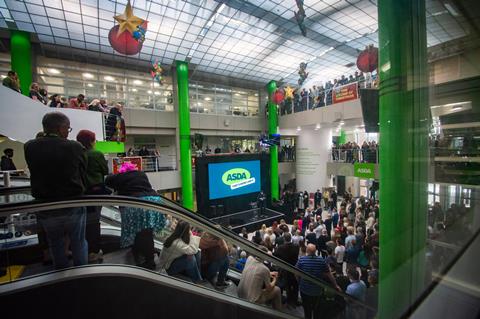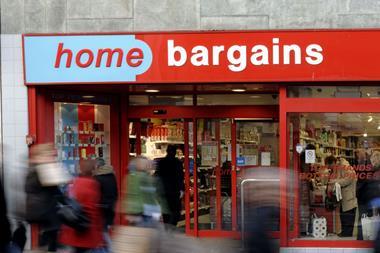After a 25-year absence, Allan Leighton was met with a rapturous reception on his return to Asda. Is he the shot in the arm it needs?
Asda is box office news right now, with every twist and turn of the rollercoaster ride it’s on dominating the news agenda.
But the revelation that Allan Leighton is back at Asda – running the show again after an almost 25-year absence – is extraordinary by any standards.
If you’re one of the 500 head office execs Asda jettisoned earlier this month, the appointment of one septuagenarian (the 71-year-old Leighton) to replace another (the 75-year-old Stuart Rose) as executive chairman isn’t that big a deal.
But this is the comeback to end all comebacks. When one considers other so-called ‘boomerang’ CEOs, has there ever been such a gap? Apple’s Steve Jobs returned after 11 years; Starbucks CEO Howard Schultz eight; Twitter’s Jack Dorsey seven; Disney’s Bob Iger five. The gap between Allan Leighton’s legendary first stint and his return is almost prehistoric by comparison.
But the £6.8bn question is: what is Asda playing at? And will it pay off?
It’s not difficult to understand what’s going on here. After its disastrous takeover, Asda’s new shareholders – a private equity consortium comprising TDR and the Issa brothers – want to recreate Asda’s glorious past. And what better way than by hiring Leighton?
Steeped in Asda’s DNA, Leighton understands the northern grit of its core shoppers implicitly and explicitly. “We knew what working people were long before Keir Starmer,” he told The Grocer when news of his appointment broke this weekend.
Vowing to “restore Asda’s DNA” Leighton received a rapturous reception on his return to Asda House on Monday in a town hall meeting that demonstrated his enduring appeal.
“Asda is bouncing after his speech,” says Savvy CEO Catherine Shuttleworth, who worked with Leighton on its customer loyalty strategy in the 1990s. “It’s a mammoth shot in the arm. And there is no better time to get a shot in the arm than four weeks before Christmas.”

No one better for the job
Of course other Asda alumni, such as Andy Bond, Tony de Nunzio and Judith McKenna, have strong experience of Asda’s DNA too (and are younger), but none (presumably) were available. And none can match Leighton’s experience: he was there in Asda’s darkest hour, when it was weeks away from going bust – forming a pivotal partnership with the then CEO Archie Norman. Now M&S chairman, Norman gave the appointment the thumbs-up.
“I can think of no one better for the job!” he told The Grocer, adding: “[It’s] not hard to improve on [its] recent performance.”
There’s certainly no motivational speaker that’s followed him inside Asda quite like Leighton. He’s written the book On Leadership quite literally (and gives the profits to Cancer Research alongside his earnings from TV and speeches). If anyone can get Asda’s demoralised workforce excited and remotivated, who can make colleagues believe again, it’s Leighton.
Even though he’s a multimillionaire, Leighton retains a common touch right down to his trademark flat cap, and cultivates an image of a man of the people, reassuring store managers and head office staff in a way that the cravat-wearing Rose could never hope to pull off.
“Stuart Rose was a monumental mistake,” adds Shuttleworth.
But second time around, will Leighton also be a mistake? Never go back they say. And the evidence for so-called ‘boomerang CEOs’ isn’t great. Of course, there have been exceptions, most notably Jobs at Apple, but research from MIT Sloan business school shows returning CEOs in the US performed significantly worse than other types of CEOs. On average, the annual stock performance of companies led by boomerang CEOs was 10.1% lower than their first-stint counterparts. Why will it be any different with Leighton?
It’s all about execution; people complicate it
Leighton has promised to get back to the basics: price, customer service and availability. “It’s a simple message,” he told The Grocer. “But these business are very simple: it’s all about execution and people complicate it.”
His first priority is Christmas: “Everyone needs to trade the business, focus on the day-to-day.”
But Leighton has given himself until the end of January to come up with a renewal plan based on maximising Asda’s “fantastic people, amazing superstores – and don’t underestimate George. Why shouldn’t it be the biggest clothing brand in the UK?”
Nor is he worried about the discounters. Leighton’s price-cutting antics – lowering prices by 10% overnight – helped see off KwikSave by the mid-1990s. So maybe he can pull off the same trick with Aldi and Lidl.
On the other hand, Aldi and Lidl are “very different beasts”, says Ged Futter, an ex-Asda buyer who worked with Leighton at the start of his Asda career. “They had only just gotten started when Archie left 25 years ago, they weren’t even on the radar. It’s a massive change.”
But the biggest difference since Leighton was running Asda isn’t the market. It’s Asda. As a leveraged buyout, Asda’s interest rate payments run to over £500m per annum. Money that could be invested in price cuts is instead being channelled into paying the bondholders who backed the leveraged buyout.
So the price-cutting tactics that first helped Asda under Leighton won’t be so easy to come by. Crucially
Asda is unlikely to be throwing off cash right now. And that’s the priority, says a senior restructuring consultant. While TDR and the Issa brothers have already taken their money out as a series of deals has paid down its debt pile from £5.9bn to £3.9bn. “Asda will be hurting from the volume and share losses it’s been recording.”
On the other hand, “the owners started in an OK place – it used to generate £1bn in cash for Walmart – and the refinance [on £3.2bn of debt] in May will have bought Allan and TDR time to figure out a plan.”
One thing is for sure, he adds: Asda is “too big to fail”. So while “it’s unlikely the shareholders will put their hands back in their pockets and TDR are extremely good at doing what they do, never say never: Asda is too big to fail for the fund, so they will work hard to give themselves time.”
Allan Leighton’s message to Asda workers, then and now
An email in September 2000 on his departure:
“Together over the past eight years we have taken our business from a basket case to one of the best companies in Britain and now part of one of the finest companies in the world.It’s you, in your different roles in the stores, depots and every part of the business, who make Asda what it is. In my early days in the company, when the going was very tough, it was always colleagues who inspired me and kept me going.As always, trade well!
Love, Allan.”
In his speech at Asda HQ on his arrival this week:
“This is a fantastic business, with fantastic colleagues, and a clear purpose in delivering the value families demand from us.
We’ve got to get back to our Asda Price position. That’s what sets us apart. Whether the weekly shop or daily top-up, in store or online, we have to provide customers with uncompromising value, every time they shop with us. I love this business. As our values say, we’re all colleagues together, one team, and together we will bring back the Asda people know and love.”
Balancing cost cutting with investment?
There will be difficult decisions to make. Like how to balance a desire to return to the glory days of ‘Asda Price’ and what Leighton used to call “the divinity of simplicity”, with the new loyalty card and the trend towards loyalty pricing, which is at odds with Asda’s EDLP position, but offers crucial retail media income, as well as insight – a key upside for TDR in the original deal (alongside a move into convenience).
From an EDLC point of view too it will be hard to replicate another of Leighton’s original plays: cutting costs. Asda has already pared them to the bone with brutal store and head office redundancies. And while Asda’s availability issues have been widely linked to the new IT systems it’s had to introduce since decoupling from Walmart, there’s also acknowledgment that the new owners have taken out too much cost from the stores and it’s hard to see how it can meaningfully improve without significantly more store colleagues. As Shuttleworth says: “One thing you know is: he’ll put shops front and centre.”
And there’s a final problem that won’t be easily solved. At the age of 71, Leighton is still sprightly, and has lost none of his optimistic, can-do attitude, as town the hall meetings at Asda HQ this week showed. But he cannot fix Asda on his own. He needs a senior team. While Asda have “thrown money at new systems,” says Shuttleworth, “systems are only as good as the people who operate them. This is going to be about the team he puts around him. It’s missing leadership in lots of key positions.”
On the other hand, if there’s one thing Leighton is good at it’s building great teams. As Futter says: “If you look at the people he had working for him at Asda, there were two future Asda CEOs, two future Sainsbury’s CEOs, and a future CEO of Boots.”
So Futter thinks Leighton will be a massive draw.
“With Allan in place, all of a sudden people will be clambering to join Asda. Because who wouldn’t want to work with Allan Leighton? Overnight Asda has become a place where you would want to be a CEO.”
That’s what TDR is hoping for: that having such an experienced and charismatic leader as executive chairman will help Asda to recruit a new CEO, after three doomed years of trying.
But even if Leighton can work his magic, and find someone to take on day-to-day responsibility, freeing him up in the future to take the more conventional backseat role that has been his hallmark in other companies he’s chaired, Asda still faces a likely 12-month non-compete – unless it’s someone more junior that Leighton mentors and trains up.
Meanwhile there will be some late nights ahead for Leighton. And hard, hard yards. Leighton has told The Guardian “a turnaround will take three to five years”.
But the good news is: even after 25 years, there’s still lots of goodwill he can call upon. “We’ve got to get the colleagues back on side. Morale is mixed. But there’s still a lot of love and passion for the Asda brand within the business,” he says.
And that’s true of suppliers too, adds Leighton. “Suppliers have felt for a period of time we don’t execute as well as we did. But when we do volume we do volume. And it helps I’ve done GroceryAid for the last three years. They all know me: and when I say I’ll do something, they know I’ll do it.”

























No comments yet